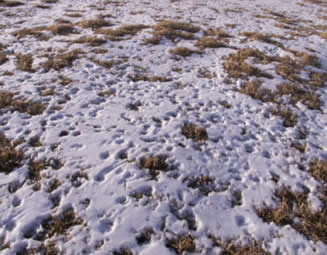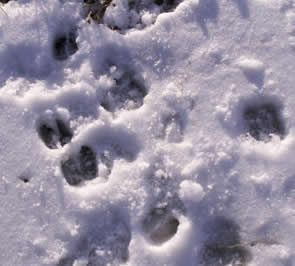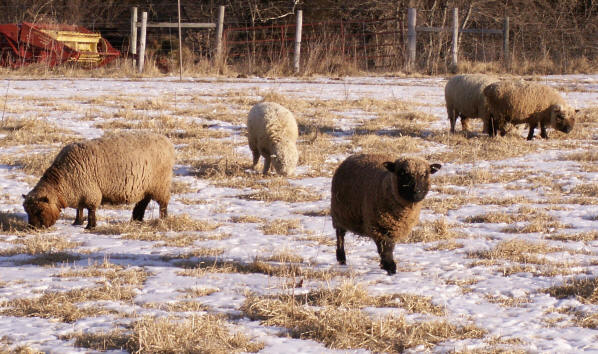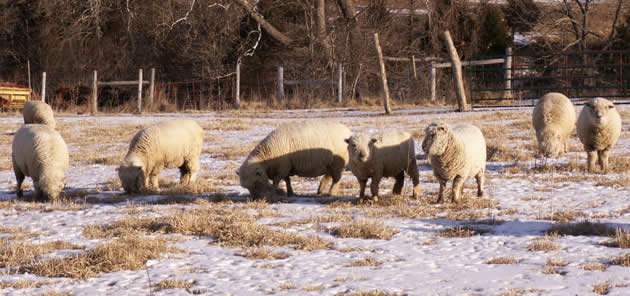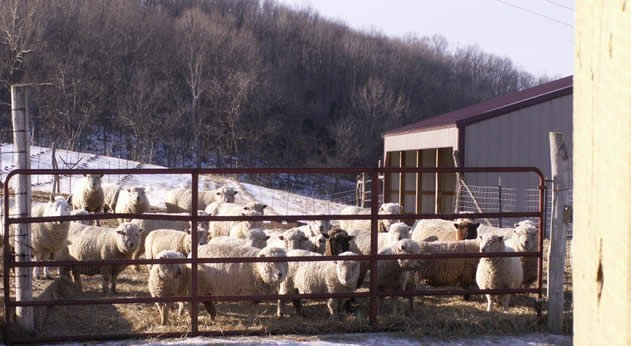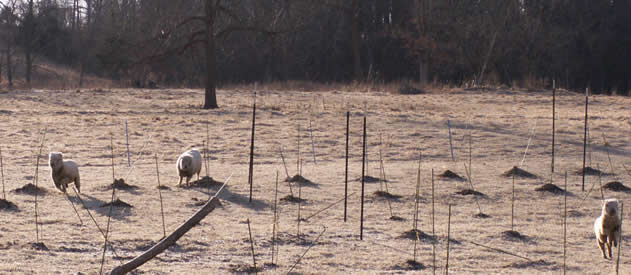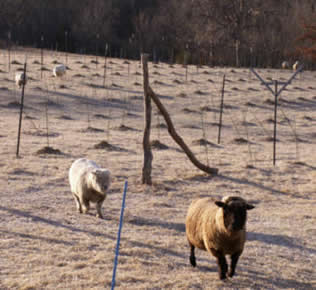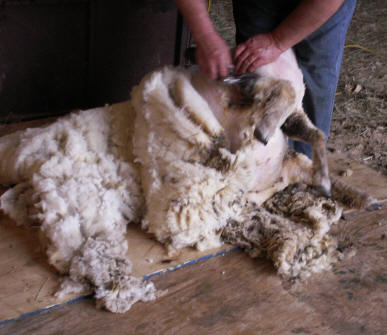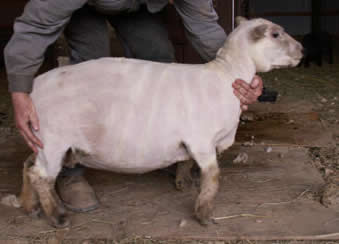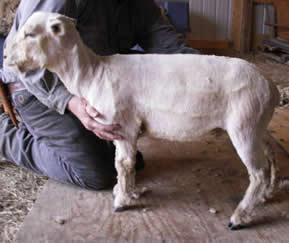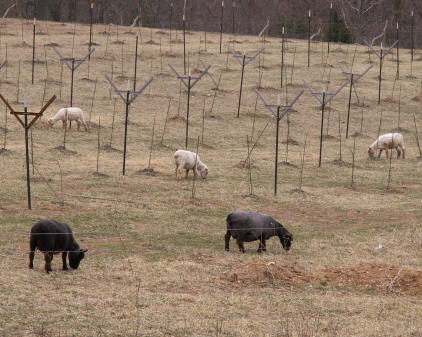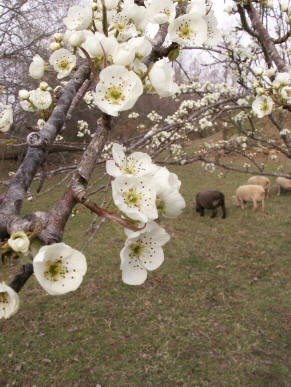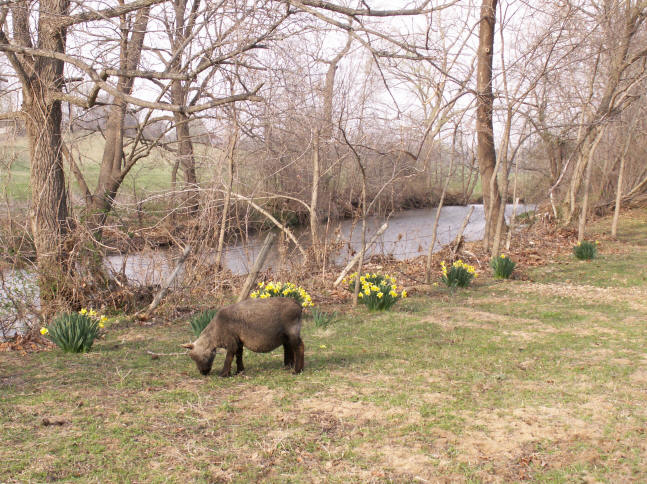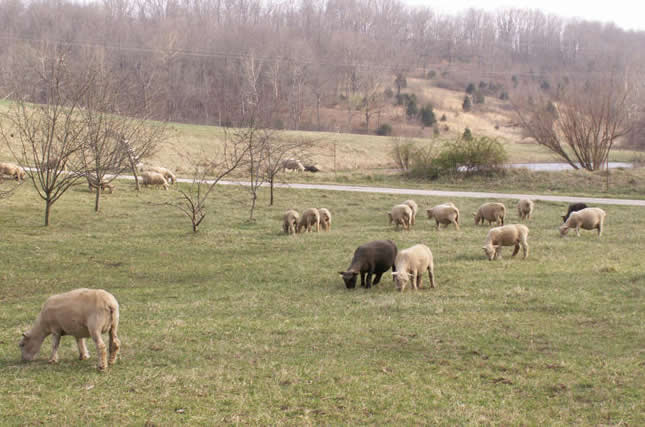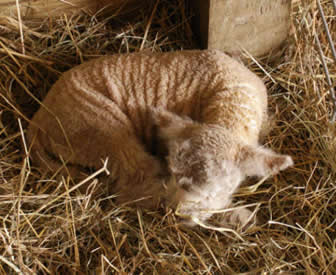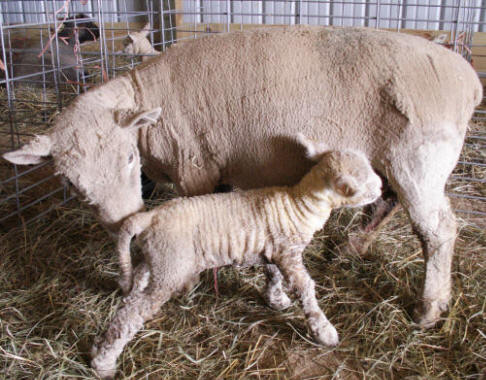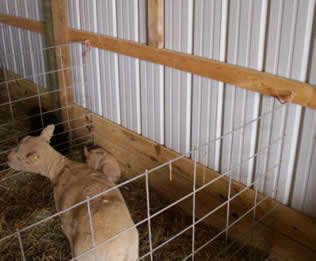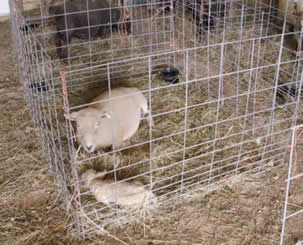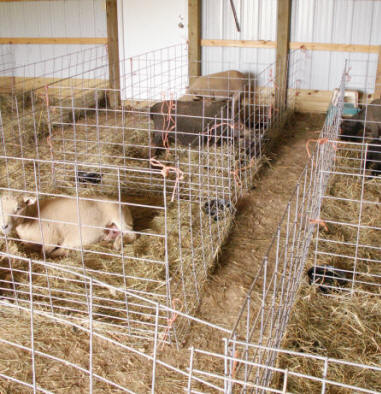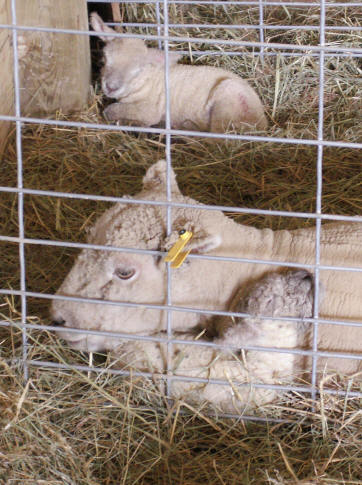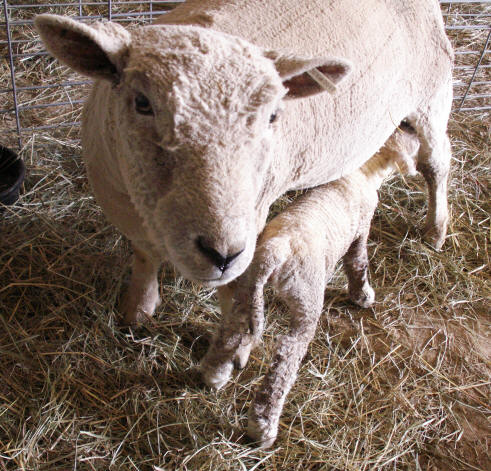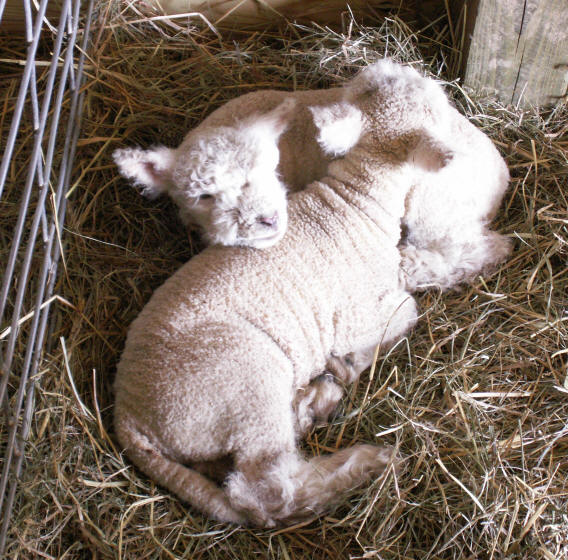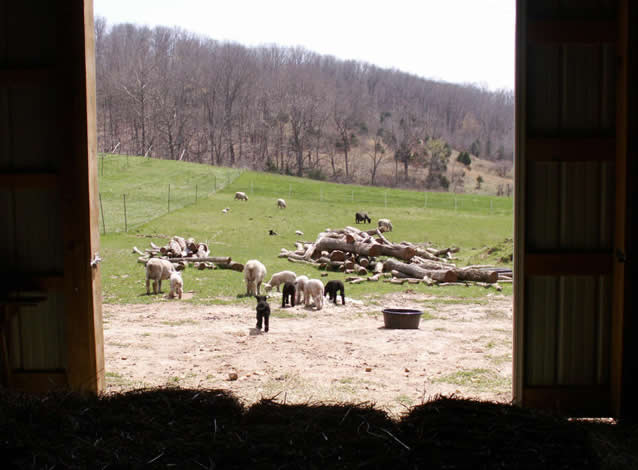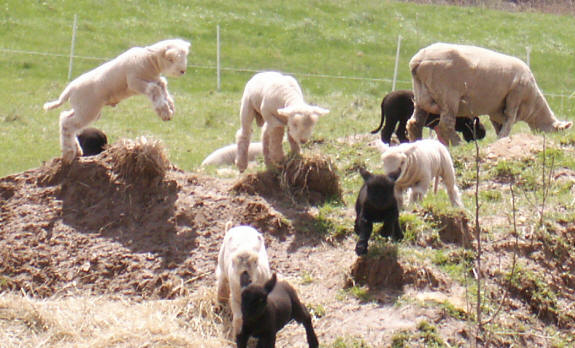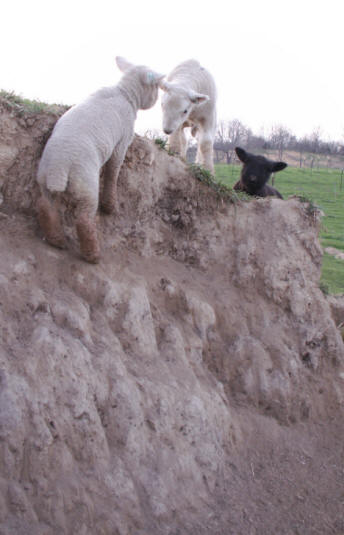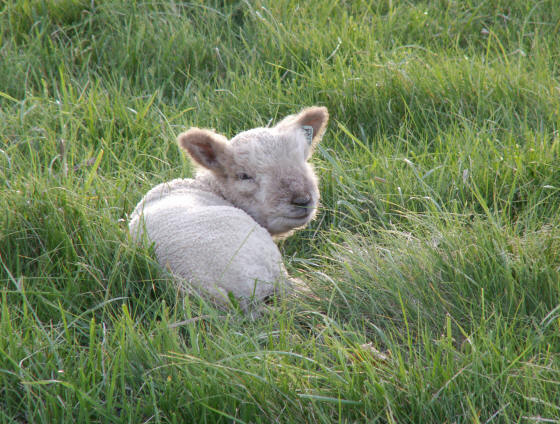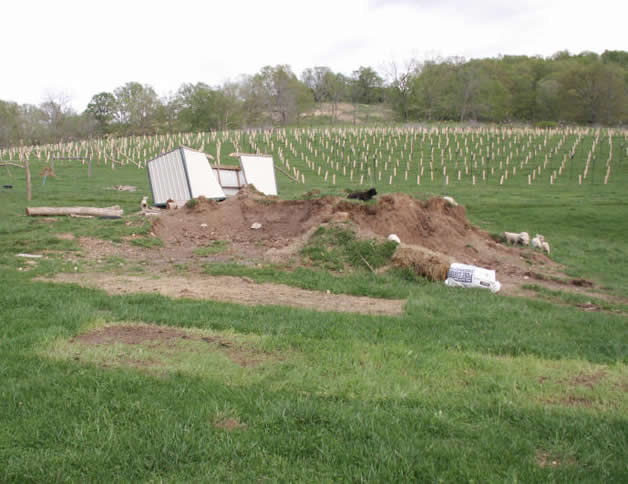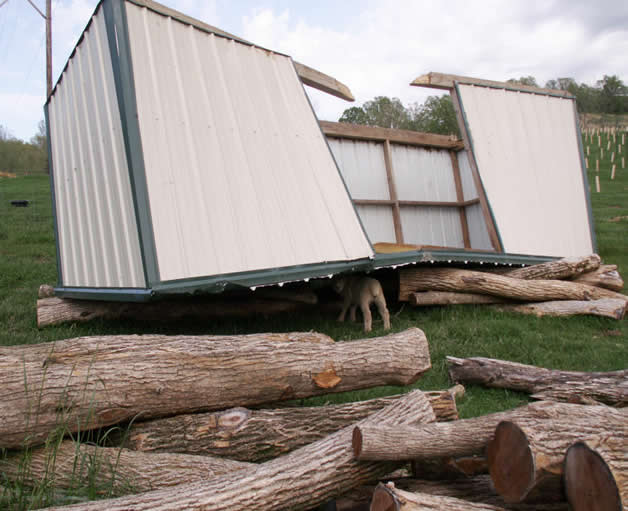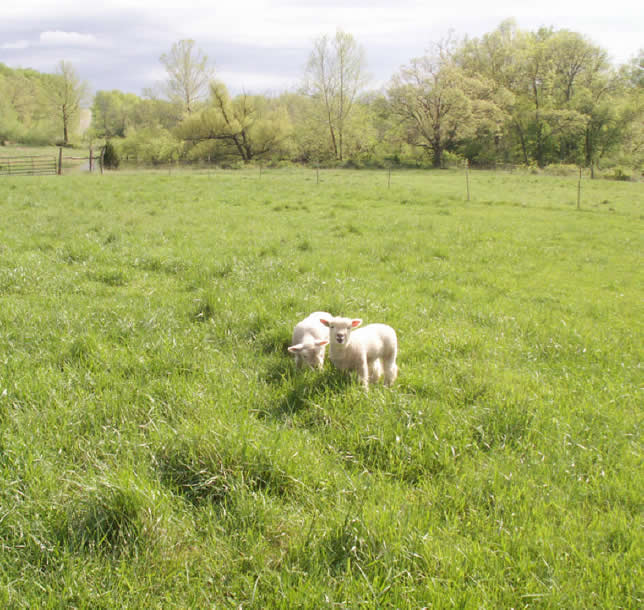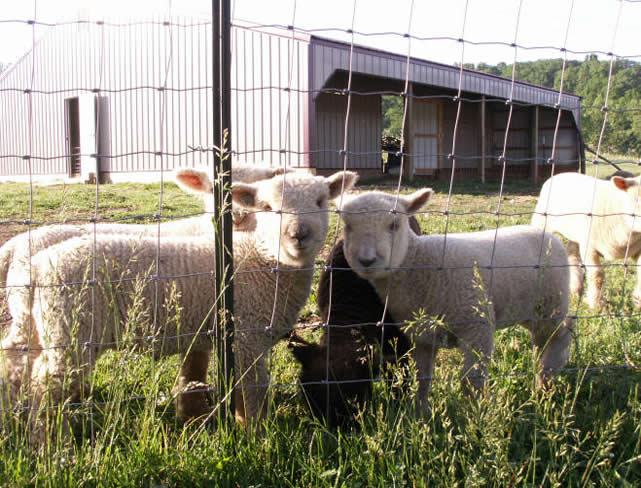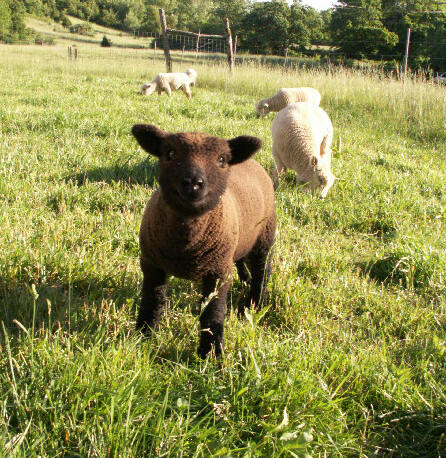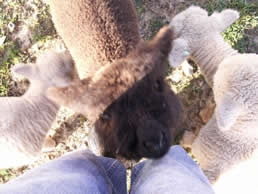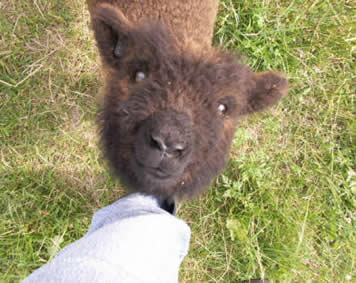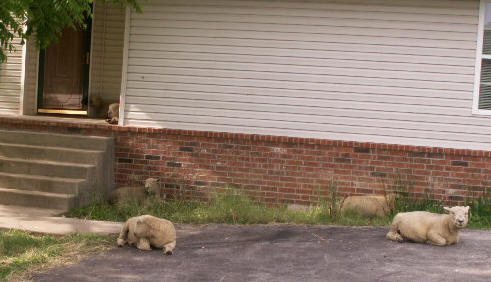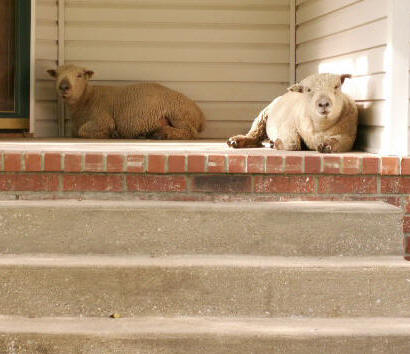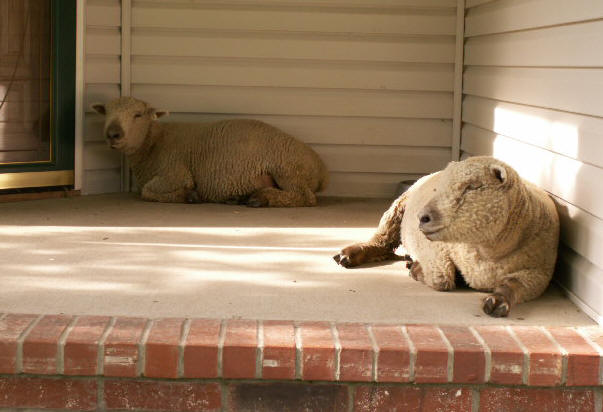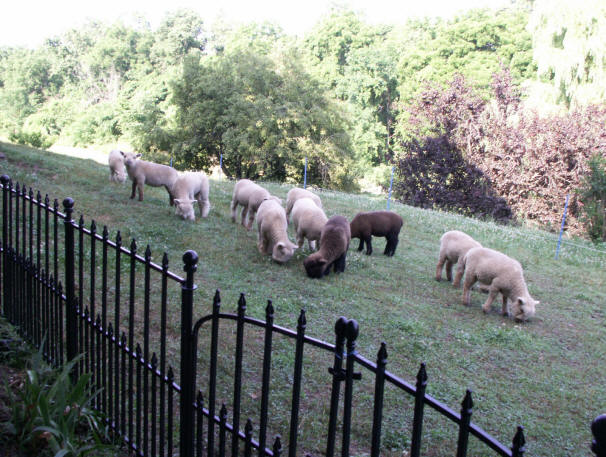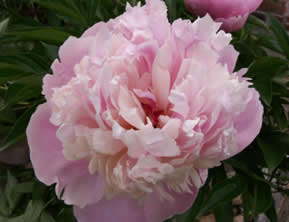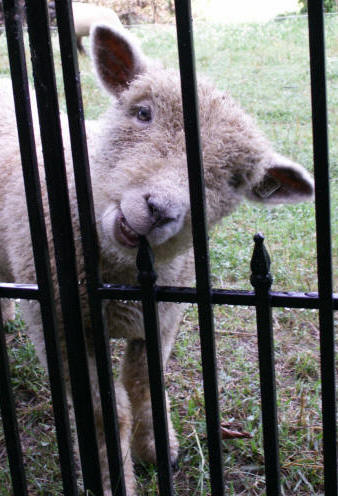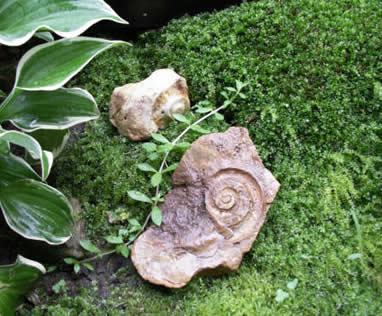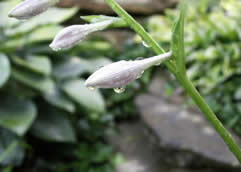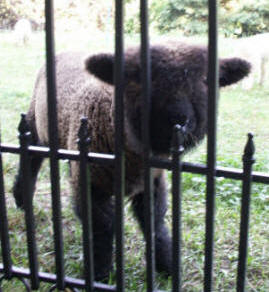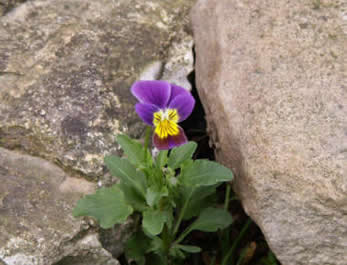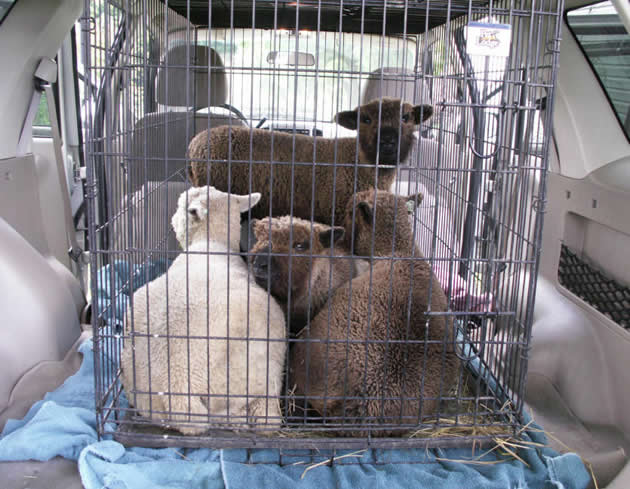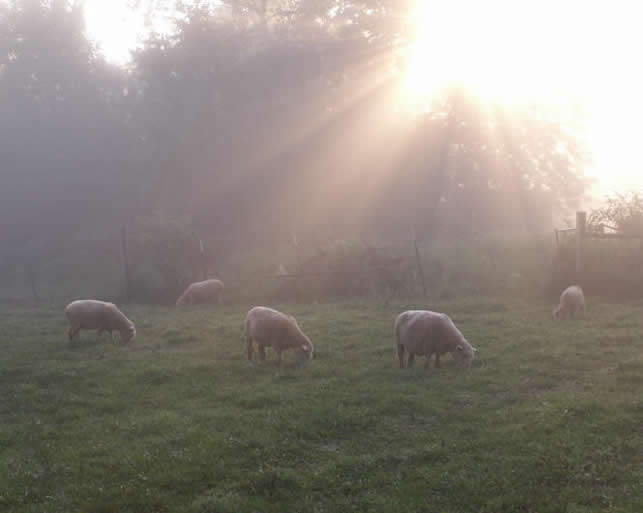February
Winter is an enjoyable time of the year for Babydoll sheep. They are very comfortable in their warm coats. There are no insects to pester them and the ground is usually not muddy. I would think that having food provided would be the best part, but one look at the snow in their pasture tells me a different story.
The flock still goes out to “graze” the whole pasture every morning and evening. I like to see this, because the pregnant ewes need to keep exercising. They have more than enough hay, but I think they view it as “fast food”. It is tolerated out of necessity, but not what they prefer.
During the middle of the day and after dusk, they return to the shed (and hay) to lay while chewing their cuds. The following picture is some of them waiting for me and the view I have from the hay stall. The mini-Cheviot ewe is on the left in the picture. In addition to the ewes that are expecting, I have two yearling wethers, a few yearling ewes (that were not bred), and two older (retired) ewes in this group. You can see their shed which is part of the sheep barn. Our new vineyard is on the hillside and is part of the pasture where they spend the winter.
The Babydolls stay on this diet of hay (along with their mineral salt and fresh water), until six weeks before they will start lambing. Then I put out tubs of stock lick that are formulated for sheep use. The tubs give them extra vitamins, and they truly love them. This is also when I start feeding them a mixture of grain and alfalfa pellets which they also adore. The reason for the extras is that these last 6 weeks are when the lambs grow the most in size. In doing so, most of their mother’s intake is going for that. Their size also leaves less stomach room for her. So she needs higher nutrition and energy at the same time that she may not be able to eat as much quantity.
It only takes two days of feeding grain for them to all start baaaaing and running as soon as they see me. They learn fast! I have to dispense the grain mixture quickly since being surrounded closely by 37 sheep (all at knee level) pushing in their excitement, is quite the experience! It would be easy to fall over one as they dart back and forth. I’ve saved up many rubber pans and tubs over the years, so I have them spaced out and attempt to stay ahead of the group. Sometimes I put a little hay in their pans before I distribute the grain, to slow them down a bit.
The ewes that are expecting lambs are really growing! Most of them round out to the sides. I’ve heard of some Babydolls getting so big during pregnancy that their stomachs almost drag the ground, but I haven’t seen that in mine yet. Last year, one ewe’s udder was almost to the ground and I was quite concerned about her. When she delivered three normal-sized lambs, I understood.
I should also make a comment about the 5 Babydoll rams, who live with a Shetland wether in another pasture. They are back to their normal life of eating, sleeping, and occasionally pushing each other around a bit. Now that breeding season is well over, they are all good buddies again and quite content with their life of ease. Unlike the ewes, the rams tend to lay around waiting for me to feed them. They seldom go out to graze or walk around although they have a whole pasture at their disposal. What a life!
The rams have a portable shed for shelter. It is actually called a hog shed and is not very high. It is designed with flaps on both the front and back. During the winter, I close the flaps on the side with the prevailing wind. During the summer, all the flaps are opened. This provides more shade and a breeze. When the “floor” gets dirty, we move it to a new spot with a small tractor. Before we had our sheep barn built, this portable shed and another were very useful. This one (that the rams use now) is my favorite of the two. It never has flipped during high winds, which we have routinely in our area during “tornado season”. The one disadvantage was when it was used for the ewes and one would decide to lamb in it–a perfect height for Babydolls, but way too short for people!
March
March brings much more activity. Three weeks before we anticipate the arrival of the first lambs, we “work” all the sheep. The main reason is that the ewes are given their yearly CD&T vaccinations so the immunities will be passed to their babies, offering protection until the lambs get their own. We also trim all their feet. Their eyes are checked using the FAMACHA system, and those that score 3 or poorer are dewormed. We are happy to see that only a few need it, and none score very low.
The following weekend, our shearer comes. This is one of the most anticipated times of the year for us. There are not many shearers available, and we really treasure ours! Sadly, sheep-shearing seems to be a dying art. Our shearer raises sheep himself so talking with him is quite enjoyable and we always learn from his wealth of knowledge.
The sheep are brought into the barn the night before so their coats are dry. The morning he is expected, I set up a pen using “hog panels”. They are attached to the walls using eye-bolts that we put at regular intervals throughout the barn. The twine from hay bales is used to tie them. As the sheep are sheared, we move the sides of the temporary pen in closer and closer. This keeps the sheep from being able to run around when we move them toward the “catch pen” our shearer has brought with him. I’ve found that when handling the sheep, it is best to try to keep them from running and getting themselves worked up. Keeping them close to each other in a small space usually keeps them the most calm. These are the last ewes waiting their turn to be sheared:
And then…a much smaller sheep emerges from all the wool…
The first ewe above is showing the signs of being in her last few weeks of pregnancy. Her belly is round although she does not show signs of being overweight. (Her backbone is not covered with a layer of fat.) Her udder is also starting to fill. The second ewe is a yearling, so was not permitted to breed last fall. The tissue along her backbone is similar to the ewe on the left, so she is also at normal weight, but she does not show the signs of pregnancy. Although these pictures do not illustrate the difference in overall size, the yearling is also smaller in length and width although she is at her full height. This is the reason I wait until the ewes are two years old to have lambs. They still have a lot to grow themselves.
There are several reasons I prefer to have the flock sheared this time of year. It is much easier for me to monitor their weight, which is very important during these last few weeks before lambing. It is also easier for me to see their udders and also watch for the physical signs that indicate the arrival of a lamb is imminent. Having the “wool tags” gone helps the lambs find their first drink easier. When they are in the pen where I will keep the ewe and her lamb the first few days, a shorn ewe takes up much less space and makes it easier for her to maneuver around her baby. When they are permitted to venture outside, a shorn ewe will usually seek a warmer area if the weather turns cold, windy, or wet. That will be a real benefit for her lamb which will not have much of a fleece yet.
After being shorn, the sheep are released to graze again. They look so small, bare, and pathetic for the first few days. As I find myself checking their ear tags again and again, I realize anew how much their fleece gives them their individuality. Then I realized this is probably how they feel when I wear a different coat and they treat me suspiciously until I speak. Maybe my voice is my ear tag to them? I am already missing their fuzzy faces and look forward to seeing them “become themselves” again this summer.
Now that the ewes are sheared, the door to the barn is left open so they can have its shelter when they wish. Amazingly, they only use it on the coldest nights, with all but the very oldest ewes preferring to sleep outside as usual. They especially enjoy laying on the hay where I feed them. I am sure they like the cushiness now that their expanding bellies are becoming more uncomfortable to lie on. I continue to give them all the hay they want to eat, plus some. They also continue to graze the pasture (and vineyard) all day, getting a lot of exercise. Their grain/alfalfa mixture is gradually increasing, and the “stock lick” tubs are always available in addition to their mineral salt and water. This is the time for pampering.
When I feed the grain/alfalfa mixture, all the sheep still come running. Some waddle very fast now since their bellies and udders restrict their leg movements. It is rather comical to watch. Each time I feed, I count to make sure they are all present. I also watch for the ones that arrive last. Sheep are well known for being stoic and hiding any problems. It is not uncommon for a sick sheep to still arrive for feed, yet not eat. So I am watching for any subtle signs that might indicate pregnancy toxemia or another of a late pregnancy problem so I can treat in the early stages. So far they are all doing fine.
The grass in our front yard was starting to grow with the warmer days. So the mowing crew was brought in to keep things trimmed…
And then, the lambs started arriving. The first two were twin ewes, one white and one black. Their sire was black, but this ewe has a tendency toward having some white lambs so her lambs are always a surprise!
After these two arrived, ten more lambs followed within the next three days. The older ewes, yearling ewes, and wethers were separated from the group, so only the pregnant ones remain. They are now brought into the barn at night. The weather suddenly turned cold and wet, so the barn is appreciated by all…maybe me most of all!
The ewes patiently encourage the lambs to nurse. Sometimes I help, but I’ve found that most of the time they do just fine without me.
When the lambs nurse, their tails flutter back and forth. But I also watch to make sure their stomachs aren’t sunken in, and that their behavior is energetic.
As the lambs are born, they are carried into a pen and their mother follows. The pens have been set up using hog panels running the length and a series of shorter ones (cut with a bolt cutter) to partition off individual pens. I set up 3 or 4 pens in each section. If I use longer partitions, I make 4 pens. The shorter partitions make 3. I aim for about a 5 X 5 foot area (or equivalency) for each ewe and lambs. The long hog panel stays in place while the partitions swing to function as gates when needed. I start by filling the far end first. It is secured to the eyebolts that are on the walls of the barn, and to each other with twine from the bales of hay. On some of the walls, I am able to leave a space at the far end. This gives me the option to empty the pens from either side. Supplies can be stored there the rest of the time.
I really like setting up the barn this way. It allows me to configure pens to meet the needs of the season. (Remember how it was set up differently for shearing?) When lambing is over, all the pens will be taken down. I can use the hog panels in other ways the rest of the year, and the barn can be used for other purposes since the sheep live outside the rest of the year (which I am very thankful for as I clean the barn each day!).
The ewes that haven’t lambed yet just roam around the open area in the other half that is not shown in the pictures of the pens. During the day, I open the large barn door and they go out to graze. Keeping that side of the barn open all day keeps the air fresher, and gets the lambs used to the temperatures outside. I haven’t ever had a case of pneumonia yet, so the ventilation must be good for them. Once lambs are dry and are drinking milk regularly, they can withstand some pretty cool temperatures. Of course, cuddling up with Mom helps too.
March ends with 9 lambs born to 6 ewes. My target date to start lambing was April 1st, so we are already well on the way!
April
By April 1st, my life is completely revolving around the sheep. Even sleep is very low on my priority list. I am wearing a footpath in the spring grass to the barn. Lambs continue arriving daily, and many choose from 2 till 4 in the morning for their entrance. Although a few still surprise me, I am able to be present for most. The main reason I want to be present is to make sure the birth sac is quickly removed from the lamb’s face so the lamb is able to breathe. The other reason is to be able to help if the lamb presents itself wrong. For most deliveries, everything goes great and I just watch. Babydoll ewes are well known for being wonderful mothers. Even the two-year old ewes that are first-time mothers handle it well. Of course there is always the exception—like the ewe that looked completely surprised that a small creature just appeared behind her! At first she jumped away, then got brave enough to s-t-r-e-t-c-h her nose out to smell him. For the first few minutes, she would startle with each of his movements, but within thirty minutes she had decided he was the most wonderful baby in the world!
Shortly after birth, I spray the umbilical cord with a solution to disinfect and help it dry up. The umbilical cord is potentially a route for infection into the lamb. If the lamb is a little slow or weak, I also give it a couple squirts of NutriDrench in the mouth, which is a solution packed with vitamins and energy.
The following picture shows the difference between a lamb about a day old (on the right) and one a few days older (left) even though the older one is actually smaller. The newborn has many folds, but within the next days will “grow into” his skin. This picture is also good for illustrating what naturally happens with many long tails if left. Here, the tails are banded within their first week when the lambs do not feel the discomfort as much as they will even a week or two later. Their nervous systems are still quite immature. Along with banding the tail, I will give a CD&T vaccination, mainly for the T (tetanus) portion. That too, only causes a minimal reaction. Many lambs seem to not feel it at all at this age.
While in the pen, I also treat the ewes by deworming them. This is the only time every one of the ewes are dewormed. The rest of the year, I do it as indicated by their “eye score” based on the FAMACHA system. I also treat them with UltraBoss–a topical solution that prevents external parasites from bothering them.
On April 11th, I have the first day without a new lamb. 39 lambs have been delivered by 23 ewes so far. Most are doing great, but there has been some sadness too… One set of twins was born to a first-time mother (2-year old) that looked like she would have a small single. They apparently grew in a very tight environment. The little ram had contracted tendons in his front legs, and his sister had a foot that turned in, probably from never being able to move while growing. A wonderful lady volunteered to do physical therapy with the little ram, trying to give him a chance for at least a semi-normal life, but after not seeing improvement and on grim expectations from her vet, he was put down. He had a short life, but he was cared for very lovingly during it. I really appreciated the efforts this lovely woman gave to him! His little sister is still here and is wearing a brace for her foot and leg. Her condition is much less severe. She is keeping up with the other lambs, hopping on and off hay bales and running around the pasture. She has such enthusiasm for life, it is easy to think that if no one ever tells her she has a disability, she may never know it.
Another very sad time was when an older ewe gave birth to triplets. The third was born dead, and the ewe seemed exhausted but fine. The next morning she still hadn’t passed the afterbirth, but then started to push again as if she was in labor. Within a very short period of time, she died. It was learned that she was actually starting to push out her uterus. This was my first time to experience anything like this. I was glad that she didn’t seem to suffer long and it ended quickly, but she was a very sweet ewe and will be sorely missed. Her two lambs are very special to me and are being raised as bottle babies.
Besides the one triplet that was born dead, there were two other lambs that also were. Both were the second lamb of twins. I am writing about these things here because this is also part of lambing. There is so much joy, surprise, and happiness…but there is also the pain and loss. They go hand in hand. Give up the one, and you give up the other too.
After about a week in the pen, the lambs and ewes are “graduated”. This means they are let out with other “graduates” into a larger pen where, for the first time, they have to work to stay together. This is really entertaining to watch! The babies run every direction hollering. The ewes also run around hollering. If there are twins, they usually go in opposite directions so the ewe can’t figure out which one to follow. At the same time, other lambs are desperate to get a drink (what all lambs do to relieve stress), so they are trying to nurse her as she tries to round up her little ones. She butts them away, and they are confused since they don’t realize they can’t drink at any fountain available. It is total chaos! After a while, everyone gets sorted out and the lambs start to understand that they need to stay close to their mother, or bad things may happen. I keep them in this area until all the lambs and ewes seem to have things figured out. Then they get to go out to pasture. This is what the ewes have been longing for. One week in a pen per year is long enough for any ewe on this farm!
As each group is graduated to the pasture, new hay is put down and the pens are filled with other new families starting out. As the last ones graduate the pens are finally taken down. This makes more room for the growing “pasture group” that has access to the barn all day, but really only comes in at night. Eventually, they will all sleep outside, but the lambs are still quite small so I like to keep a close watch on them.
After the lambs grow confident that they can find their mom if they lose her, it doesn’t take long for them to form “play groups”. They aren’t interested in grazing yet, so staying with mom all day is not as much fun as climbing and running. Some logs and a dirt mound in the pasture are a fun playground.
By the 15th of April, I have only three pens still filled with families. There are only two ewes left to deliver. They are still kept separate, since I don’t want rowdy lambs sneaking a drink from them. Their own lambs will eventually need their colostrums. The barn has been reconfigured several times to adjust to the changing size of the various groups. Presently, there is a small pen for the two ewes at night (they graze in a different pasture during the day) and a couple pens ready for when their lambs arrive. Three pens still have young families. The rest of the barn is wide open–a large area for the ewes with lambs to bed down at night. By the 23rd of April, I am leaving the large barn door open at night also. Most of the ewes are choosing to sleep under the stars with their lambs. My daily chore of cleaning takes much less time now!
On the 24th, after feeding breakfast to the bottle lambs, I returned with my camera to capture a few early morning pictures. The “King of the Mountain” in the first picture is the Babydoll/mini-Cheviot cross lamb.
May
May arrived with lots of rain this year. But that wasn’t all–the tornado weather came too. This is always part of Spring in the Ozarks. While we were in the basement, listening to the weather reports on the radio and rain pelleting the windows upstairs, my thoughts were also with the sheep. The ewes and lambs had access to the barn, so I knew they would be inside it. Whenever the winds would die down enough for me to come upstairs and take a peek, I would first look for the largest portable sheep shed. It had turned over a few times before, but we had it turned with its backside to the wind now. Maybe it would stand its ground this time? Yes, it was still there. So, back down to the basement to hear about another barn that had been lost, more trees uprooted, a roof that had collapsed at a school… Another peek out the window–yes, the shed was still there. This time I also glanced at the ram’s pasture. Not one, not two, but ALL the rams were out grazing, acting as if it were an ordinary day. Typical! I went back down. A tornado was now reported to be in our area, so wait…wait…wait… When the roar finally died down, I went up to take another peek out. The rams were still grazing. I looked to the other pasture. The shed was gone!
As soon as I felt safe enough, I ran out. The shed had traveled quite a distance, flipping over the dirt pile, finally landing on the stack of logs we use for making end-posts in the vineyard. Its flight had stopped just two feet from the electric fence!
Here are some pictures taken later the same day. (The Ozarks are one of those places where people say, “If you don’t like the weather, just wait an hour.”) The lighter colored grass in the foreground was where the shed had been standing.
(Also, in case you wonder, the rows of tubes in the background are “grow tubes” that protect young grapevines.)
As you can see, the sheep didn’t hesitate to move with their “shade” shelter to its new location.
We plan to attempt repair of the shed, and move it somewhere very sheltered for the future. One thing a person learns with farming–almost everything can either be repaired or recycled for another purpose!
Isn’t there just something incredibly beautiful about the sunshine after a storm?
June:
With June arrives probably the most tragic, heart-wrenching days in a sheep’s life–weaning. The lambs are separated from their mothers after they are fully eight weeks old. For a set of twins, one is weaned at eight weeks and the other at nine weeks. I take the larger one off first. This allows the milk demand to decrease slower, hopefully keeping the ewe from having mastitis problems. I also wait to put the ewes into a more lush pasture until at least a week after weaning. This also helps decrease their milk supply, keeping them more comfortable as they dry up.
I do “fence line weaning” which means I keep the lambs in a separate pen from the ewes, but with only a fence in between.
They stay near each other at the fence for awhile, but eventually the ewe will go off to graze. The lambs will cry, and the ewe will come running back for a very dramatic and noisy reunion. Later, she will leave again. After a few more times of this, both seem to realize that the other is still present and O.K. Most of the time, it is the lamb that seems to mourn the most. The ewes, especially the experienced ewes, seem to have an understanding of what is happening and are calm, yet stay attentive. After a day or so, the lambs settle in also. But as long as the ewes and their lambs are kept in adjoining pastures, they will sleep next to each other at the fence every night.
Before long, the lambs find their friends and start exploring and playing again. I have a new area for grazing available for them, so they gradually adjust to being their own little lamb flock. This is when I start getting to work with them again. Even with the very friendly ewes, the lambs will typically hide behind their mothers when I come near. Now they start watching me with interest and the braver ones may come up to investigate, sometimes nibbling at my clothes. Of course the former bottle babies are already my buddies. Sometimes they make walking difficult since they like to stay so close!
The lambs soon mimic their mothers’ routine of grazing in the early morning and late evening, finding a cool spot in the shade to lazily spend the hot part of the day. Around farm equipment and under vehicles are always popular spots.
Now that they are weaned, the lambs are regularly leaving for their new homes. It is always quite enjoyable for me to finally meet the people I’ve been conversing with online for some time. Others have already bought lambs in past years, so it is fun to hear their stories and updates and chat in person again. I’ve learned over the years how precious these lambs become to their new families, so it makes parting easier.
July:
The lawn crew this year has been pushing for more and more “rights”. They weren’t satisfied with just the front lawn, but also wanted access to the flower beds. Last year, I had been able to “shoo” them away occasionally and they mostly left the flowers alone. Well, this year the flower beds required a full-time security guard. I contemplated firing the lawn crew and taking over the lawn care myself, but decided that between mowing the yard and weeding the flower beds, not much time would be left for enjoying them!
Then I had an idea… I dug up all the plants I wanted to save, and moved them near a little patio area. A short fence was erected around that to keep it sheep-free. Then I turned over the entire lawn and flower gardens to the triumphant sheep, who promptly took over not only the flower beds, but also the front porch–the little rascals!
It’s probably a good thing we don’t live in town. “What would the neighbors think?”
These are some pictures of the lambs grazing outside my new “sheep-proof garden area”:
They do a great job of trimming along the edges.
The lambs like to come see what I’m doing and chat with me, but now they can’t munch flowers during their visit. We are all quite happy with the compromise…well, at least I am. Now I can have my sheep and flowers too! Less work, and more time to enjoy watching them work.
It is finally time for the last lambs of the year to leave. Since they are going out of state, I take them to the vet for their health exam for interstate travel. At this age, four can still fit in a large dog crate in the back of a Ford Escape.
Once they are on the road, they all lay down. Lambs do very well with traveling as long as they have at least one other sheep for company. Otherwise, it is more stressful and they tend to baaaa more, hopefully calling for a friend.
This year’s lambs have gone to new homes in Ohio, Colorado, Kentucky, Wisconsin, Iowa, Oklahoma, Kansas, Tennessee, and of course, Missouri.
This brings a close to the busiest time of the year for me, so it is always bittersweet. This year, I am looking forward to exploring more possibilities using their wool, so now I have time for that. I plan to share that experience on this website too, so if you are interested, please return.
August
I’ll leave you for now with a picture of the ewes enjoying their “lazy days of summer”.


